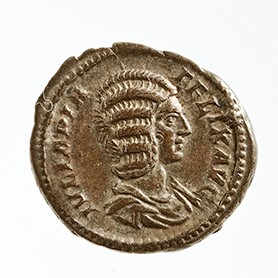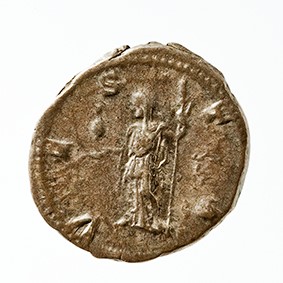Title: Denarius of Julia Domna, reign of Caracalla - 1966.52
Acquisition number: 1966.52
Author or editor: Beryl Rawson
Culture or period: Roman Imperial
Date: AD 213
Material: Metal - Silver
Object type: Coins - Roman
Dimensions: 19mm (w)
Origin region or location: Italy
Origin city: Rome
Display case or on loan: 7
Keywords: Coin, denarius, Roman, Imperial, Julia Domna, Caracalla, Vesta
Sear, D.R., Roman Coins and their Values 5 vols (London, Spink, 2000-2014) 7108; Mattingly, H., E.A. Sydenham, C.H. Sutherland, R.A. Carson, The Roman Imperial Coinage 13 vols (London, Spink, 1923-1994) IV p. 274 no. 390; Seaby, H.A., Roman Silver Coins (London, B.A. Seaby, 1967) III 230; Robertson, A. Roman Imperial Coins in the Hunter Coin Cabinet, University of Glasgow 5 vols (Oxford: Oxford University Press, 1962-1982) III 99 no. 10 and pl. 30.
Lusnia, S. Sowers, ‘Julia Domna's coinage and Severan dynastic propaganda’, Latomus 54, no. 1 (1995), 119-140.
1966.52
Denarius of Julia Domna, reign of Caracalla
3.149 g. AD 213
Obv.: Bust of Julia Domna r., draped, hair in horizontal ridges with flat bun high on back of head. IVLIA PIA FELIX AVG(usta).
Rev.: Vesta standing l., veiled and draped, with sceptre in left hand and palladium in right. VESTA.
Julia Domna had had coins in her honour in the reign of her husband Septimius Severus. After his death she tried (unsuccessfully) to keep the peace between the two new emperors, her sons Caracalla and Geta. Caracalla had Geta murdered in AD 212. He gave his mother many honours, and she was in the East when he was murdered there in AD 217. She committed suicide not long after.
Julia Domna’s obverse titles ‘dutiful/devoted’ and ‘fortunate’ belong to the period after Septimius’death. The hairstyle here is more characteristic of her later portraits. See Giacosa pl. XXXIX and XL for early styles and late styles, and Breglia 168-169 for an early style.
Julia Domna came from Syria and was associated with worship of the Sun-god (cf. 1966.53). But Vesta is one of the traditional Roman goddesses associated with imperial women from the second century on, and the restoration of the house of the Vestal Virgins early in Septimius’ reign, after a fire, has been attributed to her (Benario 716).
Sear, D.R., Roman Coins and their Values 5 vols (London, Spink, 2000-2014) 7108; Mattingly, H., E.A. Sydenham, C.H. Sutherland, R.A. Carson, The Roman Imperial Coinage 13 vols (London, Spink, 1923-1994) IV p. 274 no. 390; Seaby, H.A., Roman Silver Coins (London, B.A. Seaby, 1967) III 230; Robertson, A. Roman Imperial Coins in the Hunter Coin Cabinet, University of Glasgow 5 vols (Oxford: Oxford University Press, 1962-1982) III 99 no. 10 and pl. 30.
Lusnia, S. Sowers, ‘Julia Domna's coinage and Severan dynastic propaganda’, Latomus 54, no. 1 (1995), 119-140.

